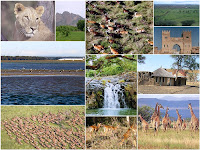Tibet
 Deciding what is ancient history and what is mysterious legend is not always an easy task. Tibet is no exception. Legend tells us that Tibetan history starts with a monkey and a Raksasi, a female ogre, when the monkey was sent by Avalokiteshvara (Chenrezi) for the religious training on this high plateau. The Raksasi persuade the monkey to marry her by threatening to kill thousands of people. Having the permission of Avalokiteshvara, they married and had five offspring who are believed to be the ancestors of the Tibetan people. This legend is well known and depicted in ancient books and murals. Even the name of Tsedang, the capital city of Shannan Region, means 'the place where the monkey plays'.
Deciding what is ancient history and what is mysterious legend is not always an easy task. Tibet is no exception. Legend tells us that Tibetan history starts with a monkey and a Raksasi, a female ogre, when the monkey was sent by Avalokiteshvara (Chenrezi) for the religious training on this high plateau. The Raksasi persuade the monkey to marry her by threatening to kill thousands of people. Having the permission of Avalokiteshvara, they married and had five offspring who are believed to be the ancestors of the Tibetan people. This legend is well known and depicted in ancient books and murals. Even the name of Tsedang, the capital city of Shannan Region, means 'the place where the monkey plays'.However, archeological and geological discoveries lead ethnologists to believe that Tibetans are descendants of aboriginal and nomadic Qiang tribes. According to archeology, Tibetan history can be traced back 4,000 years. At that time, life was simple, with stone implements being used. Historical records show that not until the 7th century could Tibetans be recognized as a race of people. The rising Yarlung Dynasty (Tubo Kingdom) unified Tibet and became an aggressive power. The first palace in Tibet, Yumbu Lakang was built for the first king of Tibet, Nyatri Tsenpo. His offspring, Songtsen Gampo, the most powerful and intelligent king of Tubo, conquered other tribes and founded the first dynasty of Tibet, Yarlung Dynasty (Tubo Kindom). Songtsen Gampo also made great contributions to Tibetan culture, economy, technology, religion, etc. by communicating with the outside world. The outstanding king of the Tubo Kingdom married two princesses of Nepal and of the Tang (618-907). The Princesses brought with them advanced technology, exotic culture, tea, silk and most important of all, peace and Buddhism. Read on >>>> Travel China Guide
More on Tibet: Tibetmap, Stockton.edu, Asianinfo, BBC, Lonely Planet, Tibet.com, Tibet.org, Tibet.net, National Geographic, Wikipedia
Image: China Review


